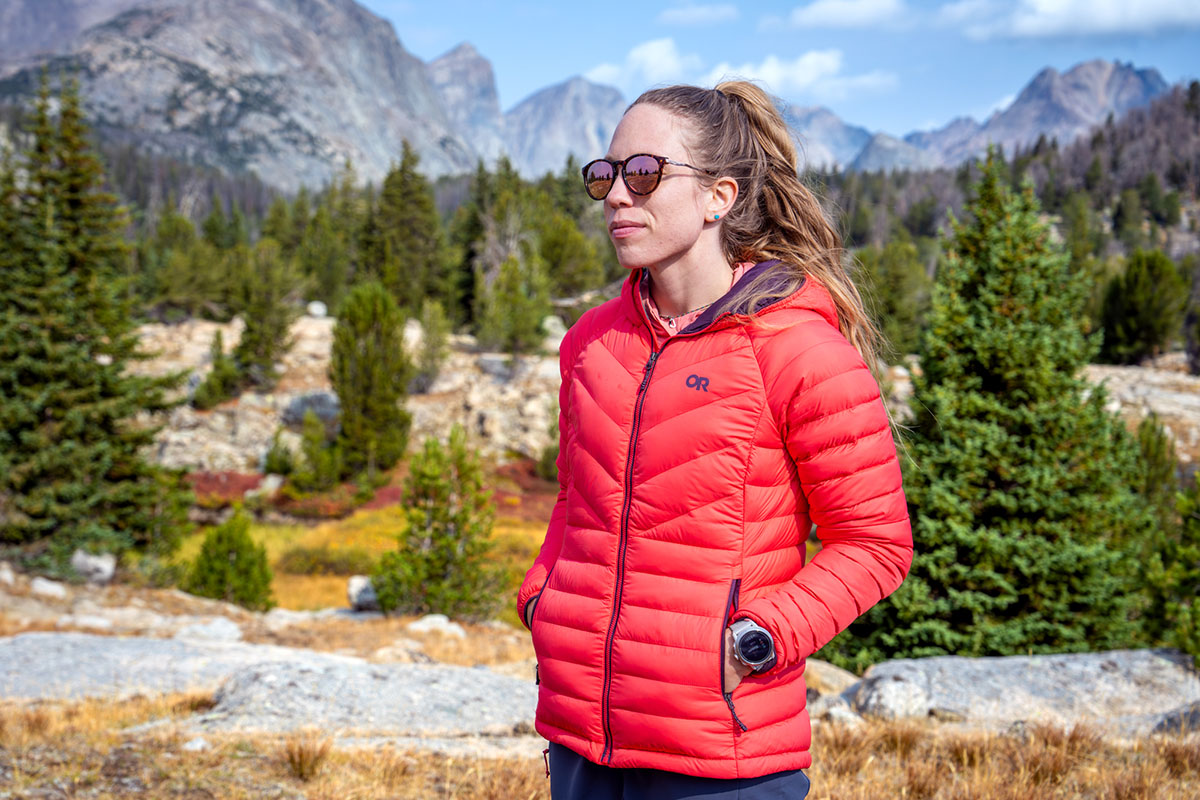
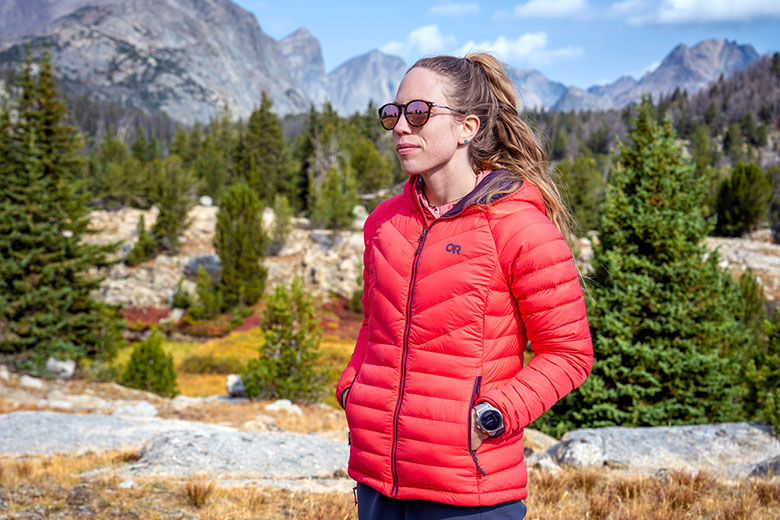
Price: $279
Weight: 11.6 oz. (women’s)
Fill: 4.2 oz. of 800-fill down
What we like: A cozy and versatile down jacket at a solid value.
What we don’t: Thin shell requires care to avoid damage; difficult to pack in its stuff pocket.
See the Women's OR Transcendent Hoodie See the Men's OR Transcendent Hoodie
Recently reintroduced after a multi-season hiatus, Outdoor Research’s Transcendent Hoodie is more backcountry-ready than ever. While past versions of the jacket used low-quality, 650-fill down, the latest Transcendent is packed with lofty, 800-fill down that makes it warmer for the weight, more compressible, and cozier to boot. Importantly, despite the performance upgrade, the jacket is still highly comfortable and everyday-friendly. It’s not the most durable option and takes some effort to get into its stuff sack, but overall, I feel OR significantly improved the jacket’s all-around appeal. Below I break down my experiences with the women’s Transcendent Hoodie. To see how it stacks up to the competition, see our articles on the best down jackets and best women’s down jackets.
The Outdoor Research Transcendent Hoodie has quickly become my go-to down jacket for casual cold-weather outings when comfort is a top priority. The supple lining feels exceptionally cozy against the skin, and the 4.2 ounces of 800-fill-power down has kept me toasty in the 40s Fahrenheit with just a t-shirt on underneath. When the temperature really begins to drop, the accommodating fit allows room to swap in a mid- or heavyweight baselayer. For comparison, the Transcendent is right in line with Patagonia’s class-leading Down Sweater Hoody, which packs in 4 ounces of 800-fill down, making it a great pairing for shoulder-season temperatures. It also makes for a nice midlayer for downhill skiing.

Weighing in at 11.6 ounces for the women’s version, the OR Transcendent Hoodie is pretty competitive in the lightweight down jacket space. For reference, it’s 0.5 ounces lighter than Patagonia's ultra-popular Down Sweater Hoody while checking in heavier than more performance-focused—and much pricier—alternatives like Arc’teryx’s Cerium Hoody (10.2 oz.) and Mountain Hardwear’s Ghost Whisperer Hoody (8.5 oz.), the latter of which is considered more of an ultralight piece.
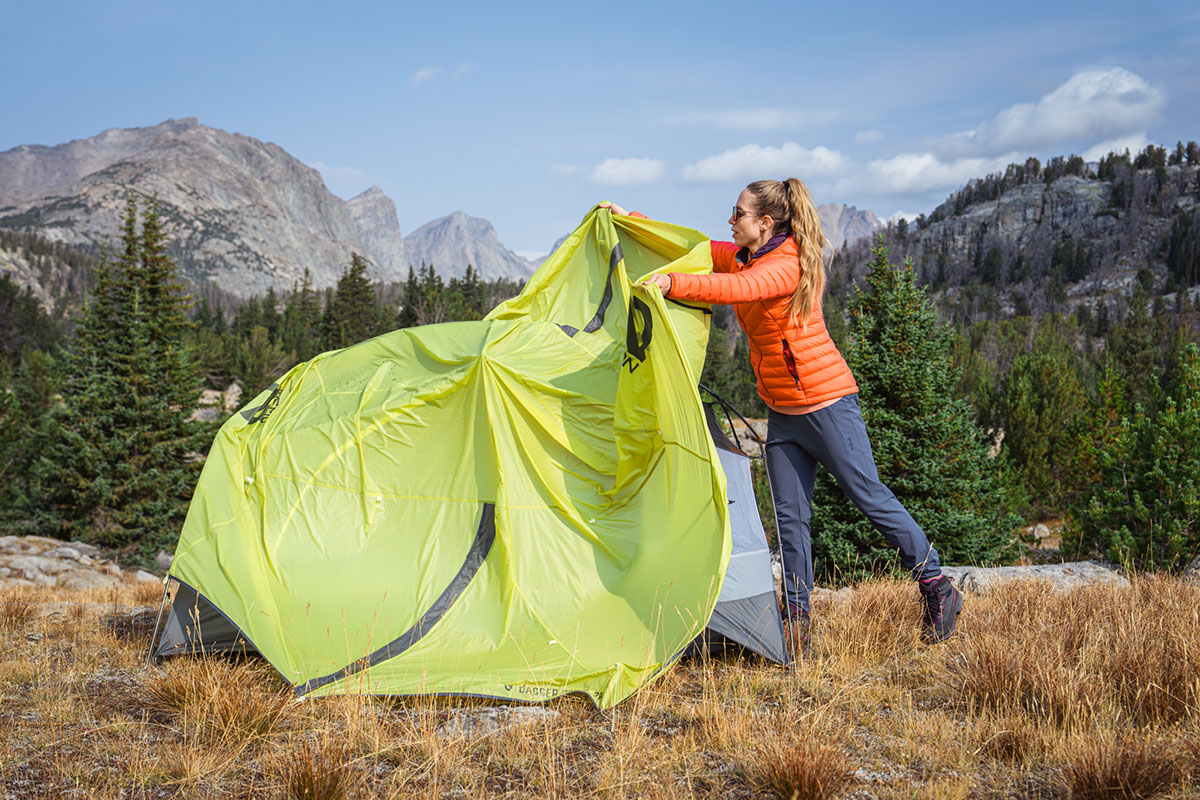
Given its weight and quality 800-fill down, the OR Transcendent Hoodie packs down respectably small for storage. Outdoor Research includes a two-sided zipper on the left-hand pocket, allowing it to double as the stuff sack, although I found it pretty difficult to get the jacket inside. Not only is it a very tight squeeze, but the pocket zipper is rather fragile-feeling, and I worry about it breaking or tearing the shell of the jacket, which is also very thin (more on this in “Construction and Durability” below). If you have the patience and exercise caution, the stuff pocket is a fine option, but I prefer to just stuff the jacket directly in my pack to fill the nooks and crannies left behind by bulkier gear, avoiding packing it next to sharp objects like tent poles.
The Transcendent Hoodie offers reasonable weather protection for around-town use, but I wouldn’t expose the jacket to sustained rain or wind in the backcountry. Despite its water- and wind-resistant nylon shell, the jacket quickly absorbs rain and snow, and I’ve been able to feel strong winds through the stitching and thin baffles. It’s true that most puffy jackets aren’t designed to shed heavy moisture, but the Transcendent seems especially prone to wetting out. If you live in a particularly wet climate like the Pacific Northwest, I recommend considering a more weather-ready synthetic jacket or a down piece that incorporates synthetic fill in moisture-prone areas (like the Arc’teryx Cerium or Himali Accelerator). Either way, it’s a good idea to carry a rain shell in your pack to fend off heavy or extended precipitation.
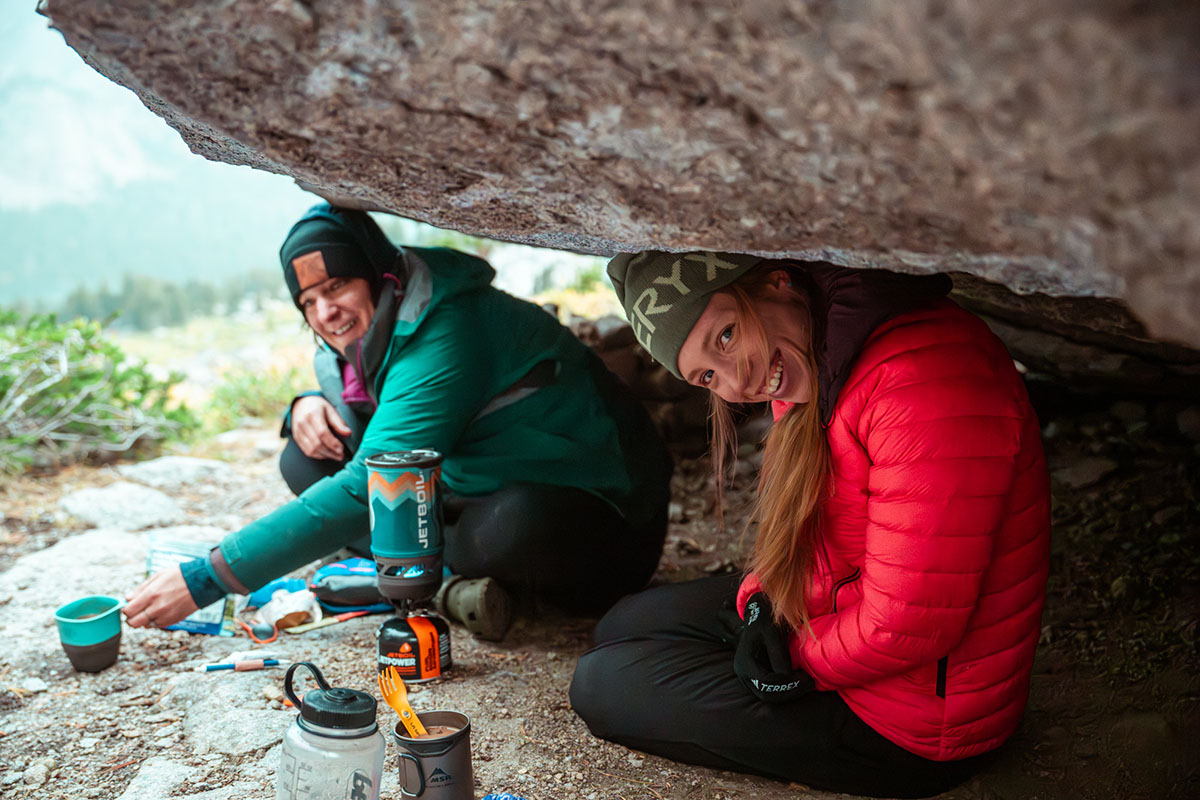
We’ve found that Outdoor Research products generally are middle-of-the-pack in terms of build quality, and the Transcendent Hoodie fits that bill. There are certainly a lot of positives to the design: The hand pockets are lined with cozy tricot that’s a boon against cold skin, while the lining and shell are both smooth and comfortable, making it easy to slide the jacket over baselayers or add a shell overtop when inclement weather rolls in. While simple, I also enjoyed the fit and design of the hood, which boasts an elasticized opening that effectively keeps it in place. And although subjective, I think OR nailed the styling component, with a flattering fit and thoughtful colorway selection (I tested the vibrant Sunrise colorway, which features contrasting zippers for a nice dose of flair).
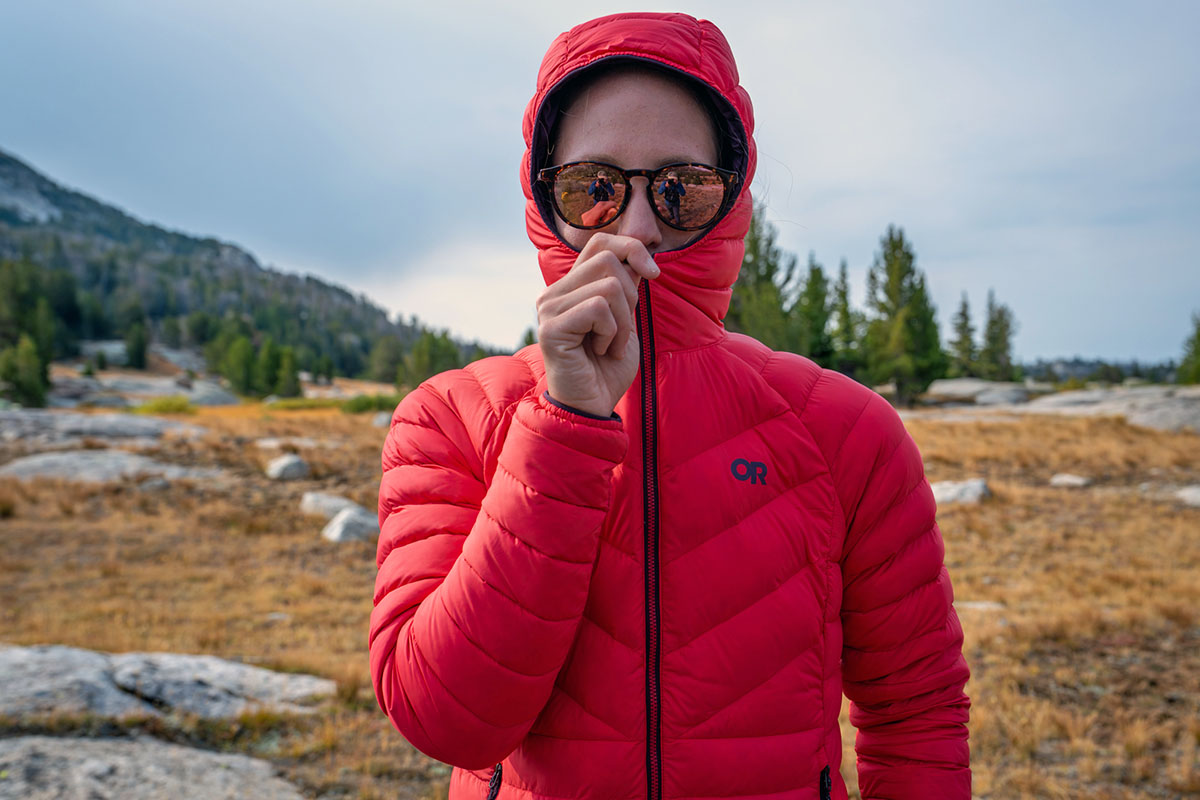
After a couple seasons of use—which has included everything from a multi-day backpacking trip in Wyoming’s Wind River Range to resort skiing throughout Colorado and Lake Tahoe—the Transcendent Hoodie is holding up mostly well. The 20-denier (D) shell is on the thinner end and did suffer a small tear on our backpacking trip, but I haven’t exactly babied the jacket, so I’m not too surprised. I’ve also noticed a couple feathers poking out, most of which have been easy to massage back inside the shell. Finally, as I mentioned above, the zippers are a little thin and fragile-feeling, which has really only been an issue when stuffing the jacket inside its pocket for storage. I worry about snagging the shell fabric on the zipper, so I try to be careful when packing the jacket away.
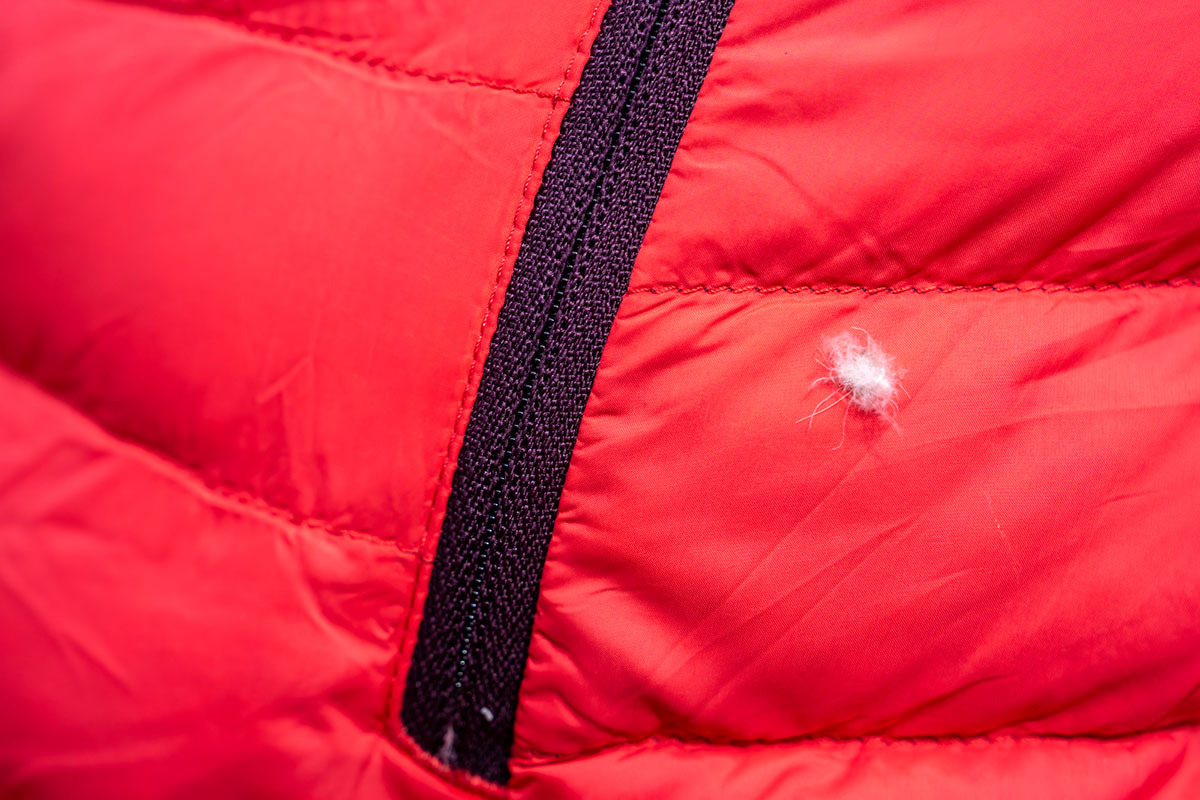
The Transcendent comes well equipped in the storage department with four total pockets: two zippered hand pockets that are lined with soft tricot, an internal zippered chest pocket that can fit a smartphone, and a single interior dump pocket on the same side. This final pocket is made from the same non-stretchy nylon as the rest of the lining, meaning it can’t accommodate more than a pair of gloves or sunglasses, but it’s nevertheless a practical space for these items. You also get an elasticized hood and cuffs, along with a single hem adjustment that creates an even cinch around the waist. All told, it’s a straightforward but entirely functional feature set that never left me wanting more.
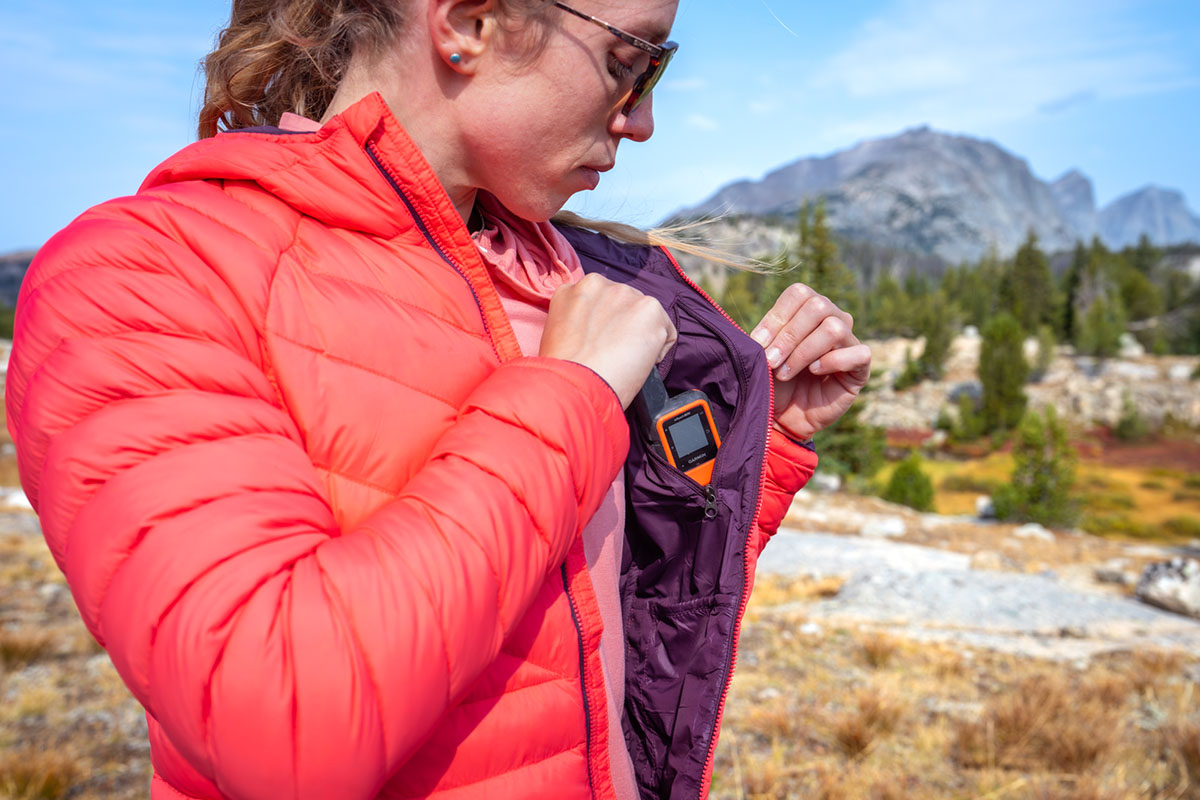
Outdoor Research describes the Transcendent’s fit as “standard,” and I agree with that designation. All told, my usual women’s small fit true to size (for reference, I’m 5’6” and around 135 lb.), with enough room to accommodate a midweight baselayer underneath without feeling overly baggy with just a tank top or t-shirt on. Some may prefer a slightly trimmer cut—like what you get with Arc’teryx’s more performance-ready Cerium Hoody—for pairing underneath a rain jacket or hardshell, but I was able to layer the Transcendent underneath my Arc’teryx Beta SL Jacket with minimal restriction. I did notice some tautness when reaching overhead and bending over, but I was able to backpack in the combo without really noticing either jacket.
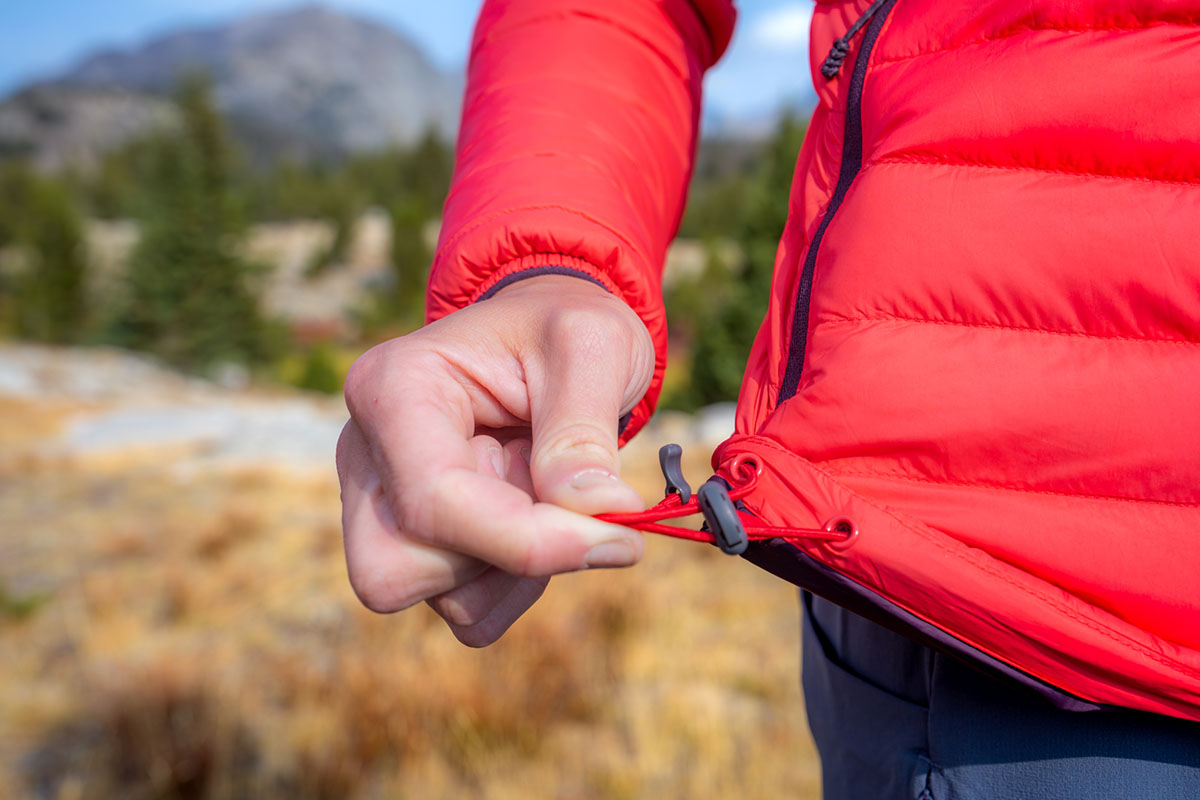
It's worth noting that the women’s style has a different baffling pattern than the men’s Transcendent, with diagonal baffles around the upper torso and horizontal baffles at the midsection and waist. This lends a flattering, nicely tailored shape that avoids the boxy silhouette of some competitors. I also appreciate that OR offers the design in a healthy range of sizes—from XS to 4X for women and S to XXXL for men—which means most folks should be able to achieve a good fit.

Outdoor Research has joined other outdoor brands like Patagonia and REI Co-op in using eco-friendlier materials for their products. In the case of the Transcendent Hoodie, OR incorporated responsibly sourced down and recycled nylon for both the shell and lining. The nylon is also bluesign-approved, indicating that it meets strict safety and ecological standards and was produced with minimal impact to humans and the environment. The use of sustainably sourced materials is becoming increasingly common in outdoor gear, and it’s nice to see another big brand like Outdoor Research join the ranks.
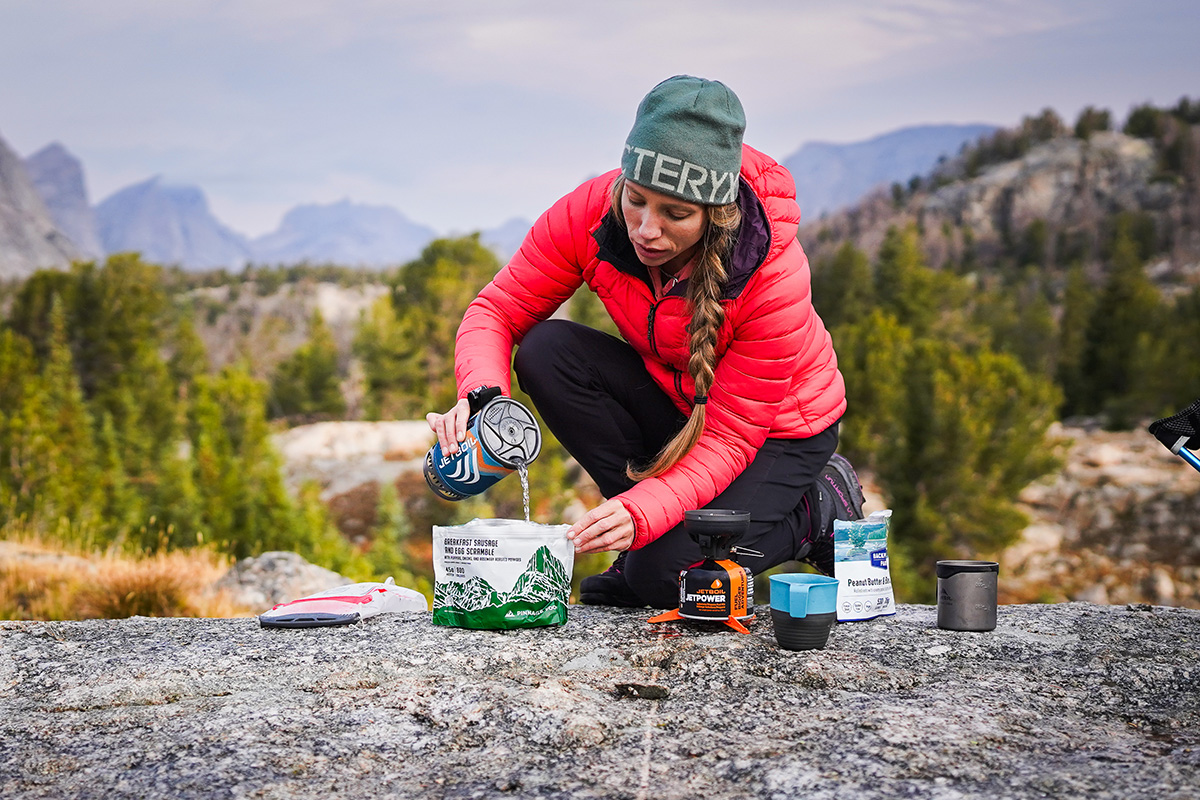
I tested the women’s Transcendent Hoodie for this review, which is also sold in a men’s version for the same price. Comparing the two, the men’s Transcendent Hoodie is a little heavier at 13.3 ounces and sold in different colorways but otherwise largely identical. Outdoor Research also makes a non-hooded Transcendent Jacket ($259) and women’s-specific Down Parka ($299), the latter of which offers additional coverage (it’s 7.5 in. longer than the women’s Transcendent Hoodie) but shares a very similar construction and feature set.

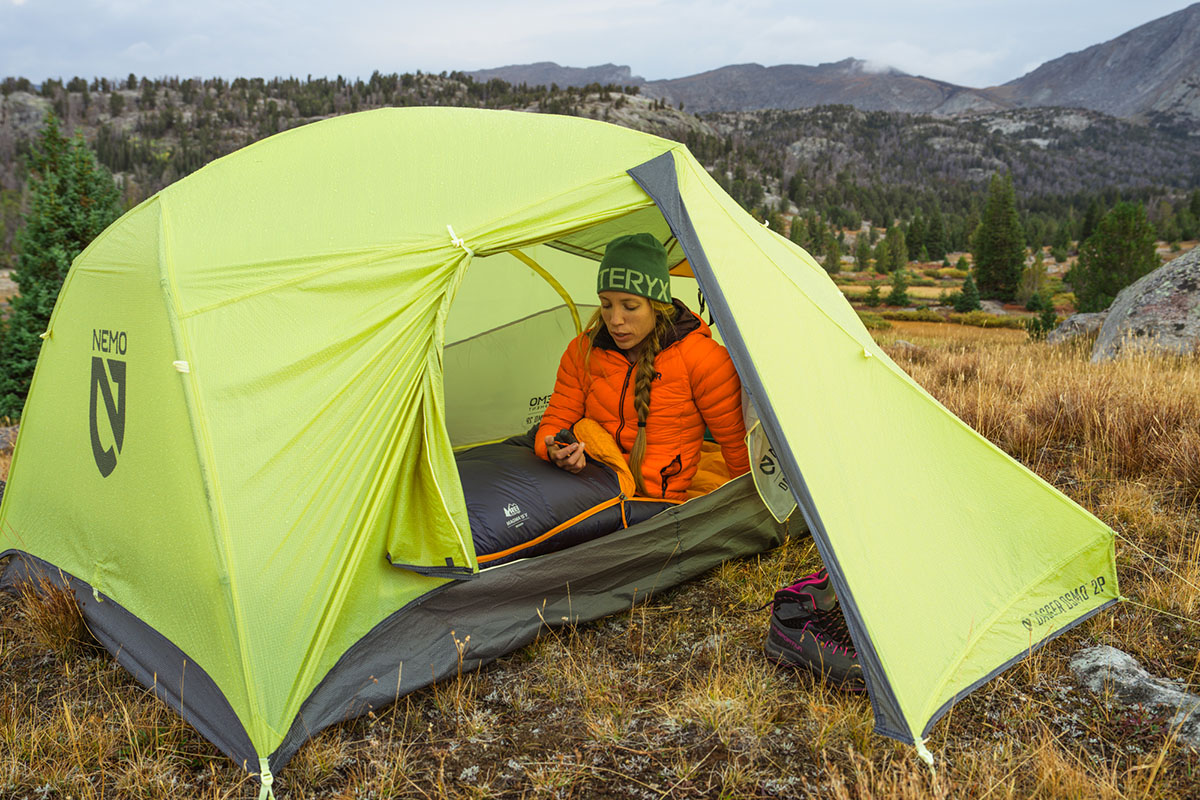
| Jacket | Price | Weight | Fill | Fill Weight | Denier |
|---|---|---|---|---|---|
| Outdoor Research Transcendent | $279 | 11.6 oz. | 800-fill down | 4.2 oz. | 20D |
| Patagonia Down Sweater Hoody | $329 | 12.1 oz. | 800-fill down | 4.0 oz. | 20D |
| Arc’teryx Cerium Hoody | $400 | 10.2 oz. | 850-fill down & Coreloft | 3.2 oz. & 80/100g | 20D |
| Outdoor Research Coldfront | $279 | 1 lb. 5.2 oz. | 700-fill down & VerticalX | 5.6 oz. & 150g | 30D |
The Transcendent Hoodie stands out for its above-average comfort and competitive warmth for the weight. In the same category is Patagonia’s Down Sweater Hoody, which sits at the top of our down jacket rankings. Both designs use a comparable amount of 800-fill down for warmth and feature relatively thin 20D shells, but the Down Sweater checks in 0.5 ounces heavier and will run you an additional $50. We consider it the higher-quality and more refined piece, but there's no denying the Transcendent's appeal from a value perspective. For a step up in performance, Arc’teryx’s Cerium Hoody is the gold standard among lightweight, backcountry-ready down jackets. It’s lighter than the Transcendent at 10.2 ounces, packs down smaller for stashing in a pack, and uses higher-quality 850-fill down for warmth. Additionally, Arc’teryx incorporates Coreloft synthetic insulation in moisture-prone areas, making the Cerium the more weather-ready piece (although we still recommend adding a rain jacket or hardshell when the going gets wet).
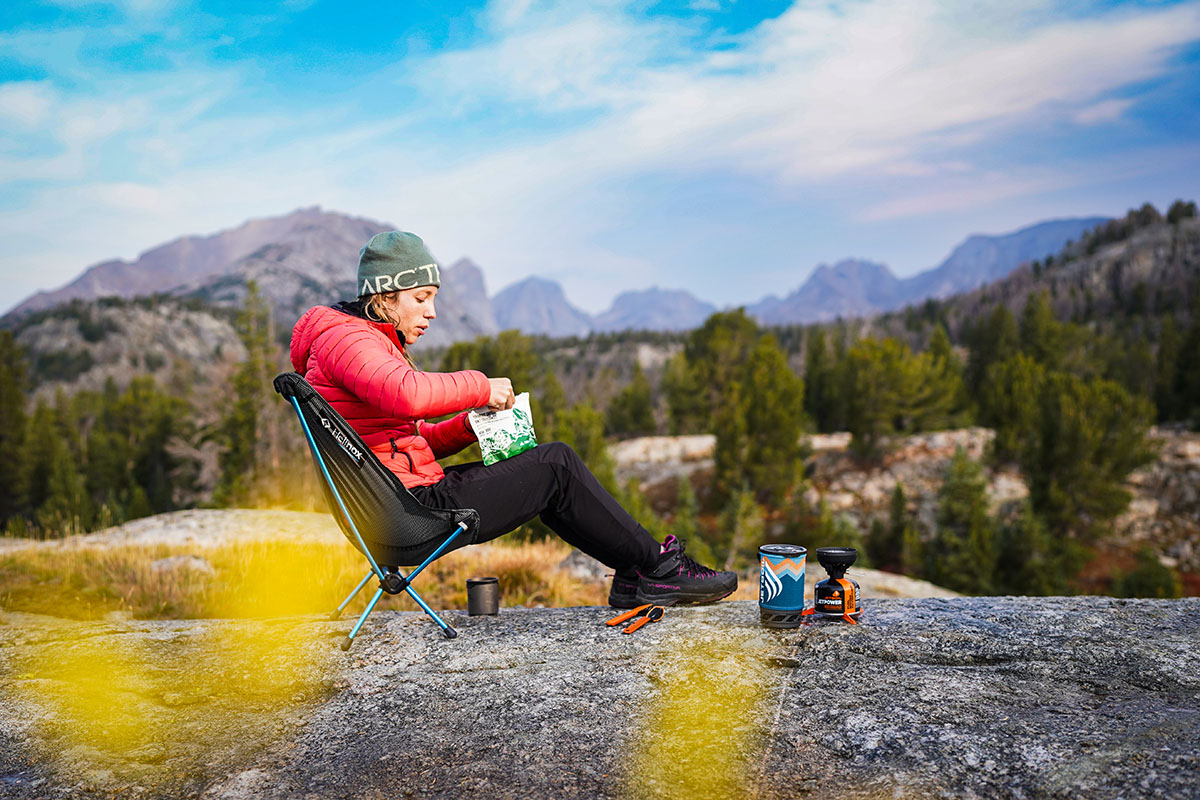
Finally, for the same price as the Transcendent, we also like OR’s Coldfront Down Hoodie. Right away, we’ll note that the Coldfront is a midweight piece, meaning it offers a sizable step up in warmth compared to the lightweight Transcendent and the two alternatives mentioned above. Specifically, OR packed in a generous 5.6 ounces of 700-fill down, which isn’t as warm for the weight as the Transcendent’s 800-fill variety but lines up well with the Coldfront’s more casual intentions. Like the Cerium, the Coldfront also boasts synthetic fill in moisture-prone areas. All told, it’s a great choice for everyday wear and casual winter adventures, while the Transcendent is the more backcountry-ready option that’s best suited for the shoulder seasons.
Back to the Transcendent Hoodie Review See Our Down Jackets Guide